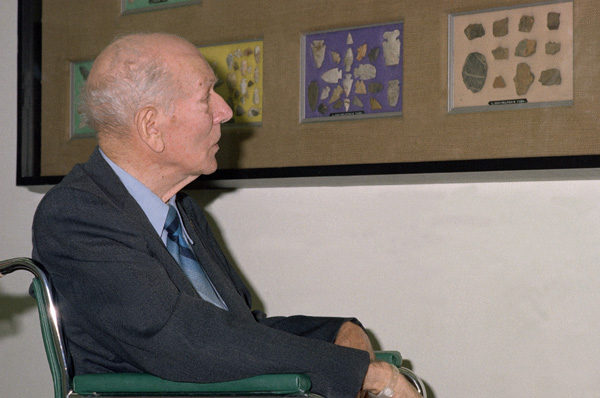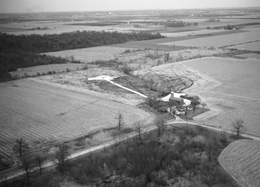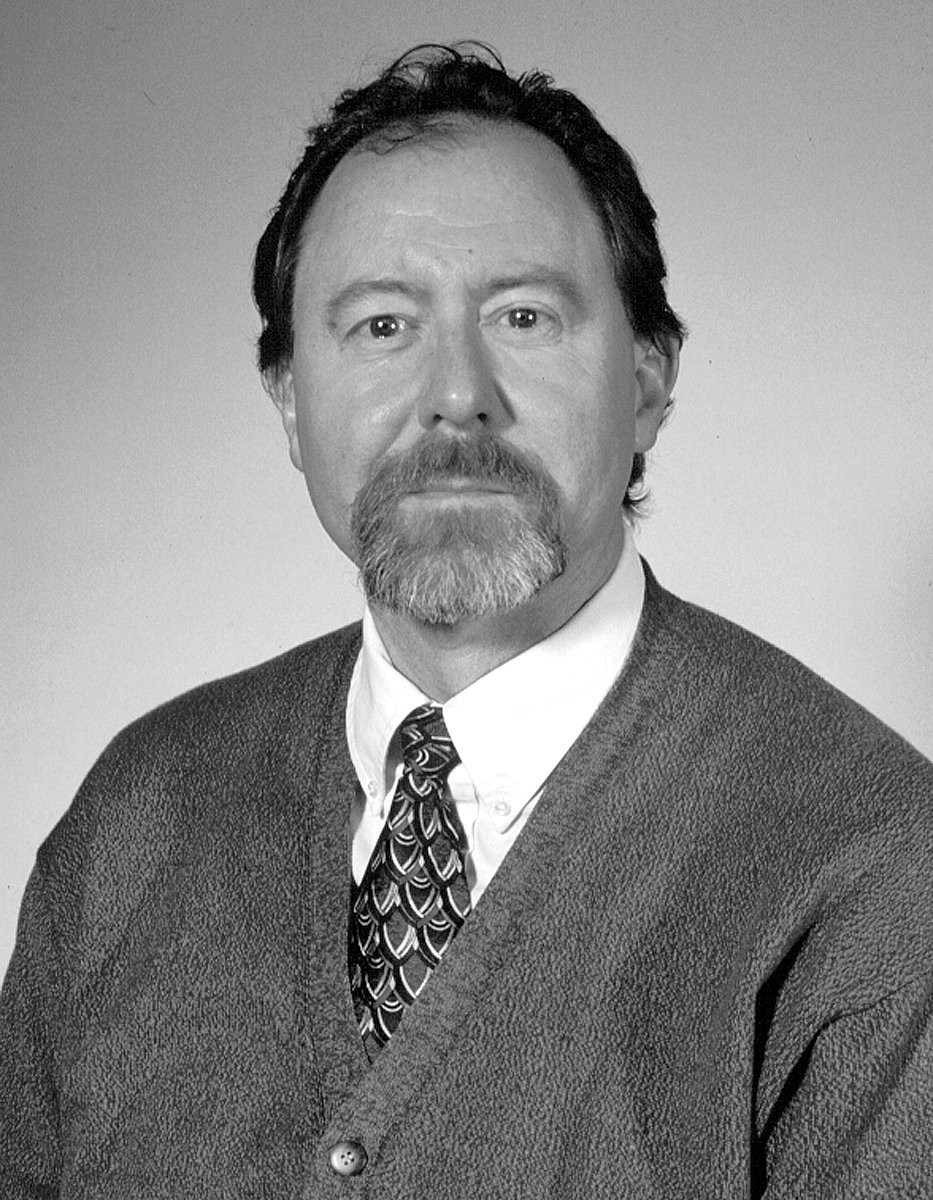 |
|
Prehistoric Artifacts Tell Fermilab's Heritage by Kurt Riesselmann Few people can claim to have been collectors for more than 80 years. August Mier, born in 1892, was one of them.
From the age of six,“Augie” collected archaeological artifacts in the Batavia area as well as across the United States. According to his own estimates, Mier collected more than 6,500 spear-and arrowheads. Among his favorite areas for finding Native American artifacts were the farms that, in 1967, became part of the national laboratory now known as Fermilab. In March of 1978, Mier donated a part of his impressive collection — about one hundred items — to Fermilab, where they’ve been on display for most of the past 24 years. According to Michael Wiant, curator of anthropology at the Illinois State Museum, three quarters of the items of the Mier exhibit at Fermilab are from what experts call the Archaic time period, spanning from 3,000 to 10,000 years ago. “It looks like a lot of people were living here [at what is now Fermilab] during that time,” said Wiant during a lecture at Fermilab on September 25.“These were small groups of people staying for short periods of time. Most likely, these people were heavily engaged in hunting activities. I would suspect that many of the main villages of these people were closer to the [Fox and DuPage] river valleys.”
Wiant has explored Native American culture and history in Illinois for more than 30 years. He has participated in several large-scale excavation projects, most notably the Koster site near where the Illinois River meets the Mississippi. “Prairies are bad places to get a meal,” Wiant said.“We see sites that — rather than being broadly distributed across Illinois’landscape — are concentrated along waterways,around upland kettles and other locations.” Archaeologists believe that the first Native Americans came to the Midwest more than 12,000 years ago, with some evidence even hinting at a 15,000-year history. Taking a quick inspection of the Mier collection, Wiant identified five pieces that are perhaps more than 10,000 years old, dating back to the Paleo-Indian time period. This makes Fermilab one of only 400 sites in Illinois with archaeological artifacts dating back to the earliest time of Native American culture in the state.
Dating artifacts is the first step in unfolding the history of humanity. Under the right circumstances, artifacts get buried in different layers of soil — as evident at the 35-foot-deep excavation of the Koster site — with each layer providing information on the age of an item. The landscape on which Fermilab is located doesn’t provide such clues. It has basically remained unchanged for more than 10,000 years. When the last glacier, perhaps more than 3,000 feet thick, melted away, it left behind the landscape seen today. For amateur archaeologists like Mier, this has presented a tremendous opportunity. With little digging, they have had access to artifacts from many different time periods. “If one looks at the Mier collection, one immediately sees that there is a whole lot of time represented, sort of compressed on this landscape,” explained Wiant.“If a tool was dropped, it essentially laid there in place. If something else was dropped there later, it stayed there, too.” Lacking geological markers, archaeologists and anthropologists apply their knowledge of historical developments and technological advances to separate artifacts of different time periods from each other. The change from spearhead to arrowhead, for example, represents a big technological leap in Native American history.
“About 500 years A.D. this technology moved across this country with lightning speed from an archaeological perspective,” Wiant explained. “The nature of the conditions that led to this invention is not clear to us. But once people got wind of it, it spread from the east coast to the west coast in just a few hundred years.” Scientists are also aware that the shape of artifacts is influenced by the person who made them, as well as the tribe and culture a craftsperson lived in. Most importantly, each artifact has a story to tell about the people that used it. “When [experts] look at a collection like this, it is not a pristine collection,” said Wiant. “It’s a collection that has been used, and it reflects use over time. Each one of those pieces has a history. We try to tell time, we try to tell something about the technology, we try to tell something about the group of people, the culture that was involved in the manufacturing of these pieces and the use of them. All of those things become part of the formula of looking at a body of artifacts and trying to draw conclusions about who lived here.” The Late Prehistoric time period, ranging from 700 to 300 years ago, right before the arrival of European settlers, seems to be underrepresented in the Mier collection. Wiant, however, attributed this fact to Mier’s preference for collecting arrowheads rather than broken pieces of pottery, which are almost absent from the Fermilab exhibit.
Archaeological studies, initiated by Fermilab’s first director Robert Wilson, support this view. In the early 1970s, when construction of the first accelerators at Fermilab was already underway, archaeologist Ann Early and a group of students from Northwestern University carried out systematic studies of five prehistoric Indian campsites that had been discovered during survey work. Keeping track of every tiny fragment, the excavations revealed a much stronger presence of Native American life on the Fermilab site than indicated by the Mier collection alone. “Results of the survey conducted during 1970 clearly indicated that the National Accelerator Laboratory property had, on several occasions, been used as a hunting and camping ground for a variety of prehistoric Indian groups,” Early wrote in her report.“The Bartelt site [a farm located in the northwest corner of the lab] had been occupied by four different groups of people over a period of perhaps 8,500 years.” Examining artifacts such as arrowheads is only one aspect of archaeology. To learn about agricultural methods, for example, scientists not only look for prehistoric tools but also seeds that were used. Dating those small objects requires modern analysis tools, some of which are based on technology used by particle physicists.
“Accelerator methodology has now been applied in anthropology and archaeology,” Wiant said. “It has revolutionized how we tell time. Prior to this, using standard radiometric assay, it would require something like nine grams of charcoal to be able to get a date with a standard error of something like a hundred years. Using accelerator methodology, we can take tiny pieces of charcoal and assay the radiocarbon fraction of them and get ideas about dating. We actually can pick up a seed and date the seed to give us ideas about the origins of agriculture.” Using accelerator technology, scientists have dated the introduction of corn to the Midwest at about 600 years A.D. Two hundred years later, Native Americans planted the first beans in Illinois. These new sources of food, which could be stored for consumption during the winter, led to the development of larger villages with populations of about one thousand people. The most profound change in Native American life, however, began in 1673, when French settlers arrived in Illinois. Less than 175 years later, government agents forcibly removed the last members of the Potowatomi tribe from the state. Today, Native Americans again call Illinois home. In the Chicago community alone, there are about ten thousand people from a variety of different tribes, representing the broad heritage of Native American people. “There is a remarkable record of human history,” Wiant concluded his lecture at Fermilab.“A part of the story is told right here on this landscape.” Due to the renovation of the exhibit area on the 15th floor of Fermilab ’s Wilson Hall,the Mier collection has been in storage since 2001.Fermilab officials plan to make the collection available to the public again by the end of 2003.Recognizing the value of cultural resources on the site,Fermilab and the Department of Energy have prepared a Cultural Resources Management Plan to direct the handling of discoveries such as the Mier artifacts.They are to be administered in a spirit of stewardship for future generations, in accordance with the National Historic Preservation Act.
ON THE WEB:
|






